Are you a Quiet Speculation member?
If not, now is a perfect time to join up! Our powerful tools, breaking-news analysis, and exclusive Discord channel will make sure you stay up to date and ahead of the curve.
Successful Magic decks are like well-oiled machines: the pieces fit together well enough to ensure they enact their gameplans consistently and effectively. They owe their cohesion to enablers, cards that supercharge certain gameplay mechanics or themes (i.e. "artifacts matter"). Just like payoff cards, or the ones newer players crack in packs and immediately want to cast, enablers incentivize players to take their deckbuilding in a given direction. Modern is a format as defined by its removal as by its enablers. Today, we'll continue in the tradition of last year's Modern Top 5 series to assess its best ones.
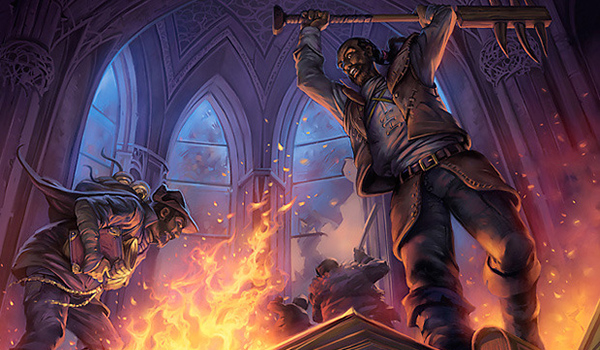
Enablers Beware
We've come a long way from Faithless Looting being a sleeper card. Enablers enjoyed quite a bit of limelight last year, with some players even calling for their bannings. But I think, barring certain scenarios, that banning enablers goes against the spirit of Modern.
 Since diversity is far and away the most important factor for Wizards when it comes to managing Modern, any enabler that successfully supports multiple strategies (even if one is oppressive) is probably safe. It seems to me that banning louder offenders like Krark-Clan Ironworks is more in line with the company's format goals.
Since diversity is far and away the most important factor for Wizards when it comes to managing Modern, any enabler that successfully supports multiple strategies (even if one is oppressive) is probably safe. It seems to me that banning louder offenders like Krark-Clan Ironworks is more in line with the company's format goals.
That said, wizards has pointed to these cards being on their radar as recently as the latest Banned and Restricted Announcement, and made a point to reveal that the enablers "are not being given a free pass in perpetuity." Still, the same announcement reinforces the idea that consistency tools will only be banned if they result in a diversity decrease.
When we examine the effect of powerful cards, we consider whether they are increasing or decreasing the number of viable decks in the environment. In the current state of the metagame, the build-around nature of Ancient Stirrings supports decks that look very different from a simple collection of the strongest rate cards, and that otherwise may not exist. The recent resurgence of a new generation of Amulet Titan decks is a good example of this. Mox Opal is a similar case. In addition to showing up in high-profile decks like Hardened Scales, we also see Mox Opal enabling a variety of more fringe artifact synergy decks.
As Stirrings and Opal inhabit a wide range of decks, unlike, say, Wild Nacatl did, they are safe from the banlist. To be banned, Opal would have to make one deck so powerful that other Opal decks could no longer compete, or Wizards would have to reassess how they feel about Modern's existing fast-mana options. That other enablers were not even mentioned in the announcement bodes well for the stock stability of this sort of card in general—go ahead and spring for those foreign foils!
What's In a 'Nabler?
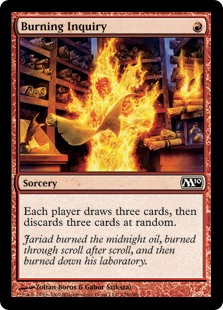 Unlike many best-of lists, Modern Top 5 seeks to establish parameters that explain its ranking. Grades are given out of 15, with three different metrics being counted out of 5; cards with more points are ranked higher. This system is not without its faults: some metrics are perhaps more important than others when it comes to a card's playability, but the metrics are not weighted; similarly, while doling out numbers removes a degree of subjectivity from the process, the numbers assigned and metrics chosen remain eminently debatable. The system's purpose, then, is less to create a definitive list than to pave the road for a structured debate surrounding the cards' playability in relation to one another.
Unlike many best-of lists, Modern Top 5 seeks to establish parameters that explain its ranking. Grades are given out of 15, with three different metrics being counted out of 5; cards with more points are ranked higher. This system is not without its faults: some metrics are perhaps more important than others when it comes to a card's playability, but the metrics are not weighted; similarly, while doling out numbers removes a degree of subjectivity from the process, the numbers assigned and metrics chosen remain eminently debatable. The system's purpose, then, is less to create a definitive list than to pave the road for a structured debate surrounding the cards' playability in relation to one another.
There are two metrics I always use when evaluating cards for Modern Top 5.
- Power: The degree of impact the card tends to have for its cost.
- Splashability: The ease with which Modern decks can accommodate the card.
From Modern Top 5: Utility Cards:
Power and flexibility will be rated by considering both a card's floor (the least it will do) and its ceiling (its best-case scenario). For example, Lightning Bolt's power floor is higher than Fatal Push's, as Push is dead when opponents have no creatures while Bolt can go to the face.
Splashability will be rated by considering how many existing Modern decks can accommodate the card and whether they'll want it. For example, despite its lack of a color identity, Ghost Quarter doesn't fit into BGx midrange decks. These decks can easily run Fulminator Mage as mana disruption instead, and prefer not to miss a land drop if they don't have to.
As usual, we'll also add a third metric, or "guest judge," into the equation.
- Resilience: The degree to which the card proves unfazed by targeted or splash disruption.
Resilience describes an enabler's ability to function under pressure. Cards like Thalia, Guardian of Thraben, Chalice of the Void, and Damping Sphere are Modern mainstays, and each of these mess with a subset of played enablers. Factors to consider when judging resilience include how common the top hate cards are in the format, whether they see mainboard play, and the amount they cramp the enabler in question.
With our method outlined, let's roll out the contestants!
#5: Thought Scour
Power: 2
Thought Scour's effect is relatively minute, especially for the mana it charges. But it does enable otherwise impossible plays, like turn two Tasigur, the Golden Fang with Stubborn Denial up out of Grixis Shadow, and help 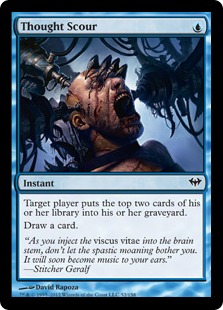 Snapcaster Mage be more of a toolbox than ever. Lately, Scour is seeing play in UR Phoenix, where it has the upside of hitting a card with flashback or the deck's namesake creature. In these cases, the card ends up a +1 or better for just one mana.
Snapcaster Mage be more of a toolbox than ever. Lately, Scour is seeing play in UR Phoenix, where it has the upside of hitting a card with flashback or the deck's namesake creature. In these cases, the card ends up a +1 or better for just one mana.
Scour is at its worst when there are no payoffs in sight or in reach and pilots find themselves light on mana sources. Here, digging deeper into the deck for blind tries to find a land ends up too expensive, making players ripe for punishment from opponents. Similarly, in the mid- to late-game, the graveyard may be plenty stocked for whatever pilots have in store; Scour is then superfluous. Nonetheless, it does cycle into the next card, if for a mana and the small possibility of either milling a key card or, when targeting opponents, enabling their synergies.
Resilience: 3
A major historical failing of Scour's is that it incentivizes players to invest heavily into graveyard synergies. But doing so opens them to splash hate run in sideboards for decks like Dredge, such as Rest in Peace. As such, to run Scour is to walk a tightrope between extracting enough value from the cantrip to justify it over other options (most directly, Opt) and not designing a worse graveyard deck than Modern's lynchpin ones that loses to the same cards.
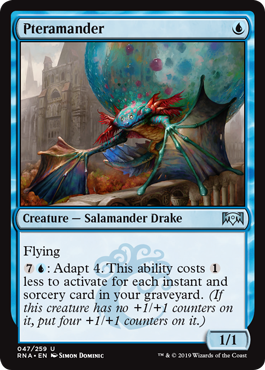 I faced this problem head-on while brewing UR Delver a couple weeks ago. Solutions include diluting the graveyard plan post-board, as is possible in Temur decks by removing creatures like Tarmogoyf for ones like Huntmaster of the Fells, and running cards that function okay under graveyard hate but still benefit from a mass of cards there, such as Snapcaster Mage and Grim Lavamancer. The best strategy in my eyes, though, is freshly available: to lean on a Crackling Drake Plan B, which extracts value from every Scour no matter the opponent's hate cards.
I faced this problem head-on while brewing UR Delver a couple weeks ago. Solutions include diluting the graveyard plan post-board, as is possible in Temur decks by removing creatures like Tarmogoyf for ones like Huntmaster of the Fells, and running cards that function okay under graveyard hate but still benefit from a mass of cards there, such as Snapcaster Mage and Grim Lavamancer. The best strategy in my eyes, though, is freshly available: to lean on a Crackling Drake Plan B, which extracts value from every Scour no matter the opponent's hate cards.
There's also the issue of spell-count hosers like Thalia, Guardian of Thraben and Damping Sphere. Scour has a leg up over its sorcery-speed sisters here, though, since it can be thrown on the opponent's end step or in response to the 2/1.
Splashability: 2
Any deck with both graveyard synergies (most of them) and blue (a minority) can accommodate Scour. Those decks should also be spell-based, as otherwise, there are simply better options for turbo-charging the graveyard. But as a one-mana cantrip, Scour has what seems like a permanent niche in the kind of strategy that also plays sorcery-speed blue cantrips, Lightning Bolt, and threats that benefit from one-mana spells.
Overall: 7/15
#4: Manamorphose
Power: 3
On its surface, Manamorphose does nothing. Players get their card back, and their mana back. So why run it? For the filtering? For the deck thinning? For the lulz? These questions are typical of new Magic players, but not of Modern veterans, who understand the card's power lies with the scope of what it allows. This format features cards that reward players for:
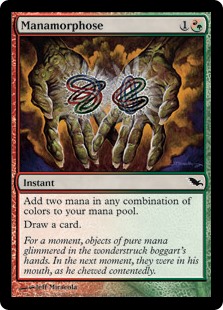 Casting instants/sorceries (Arclight Phoenix, Thing in the Ice, Monastery Swiftspear)
Casting instants/sorceries (Arclight Phoenix, Thing in the Ice, Monastery Swiftspear)- Having those cards in the graveyard (Snapcaster Mage, Bedlam Reveler)
- Having those cards in exile (Crackling Drake)
- Having those cards in the deck (Delver of Secrets)
In a shell featuring cards from multiple bullet points, Manamorphose is among the deck's best cards. Consider the Precognition Field decks I brewed back in March; all of them abused Manamorphose for multiple purposes. Or, more compellingly, look at UR Phoenix's results in Modern.
Resilience: 2
For all its enabling power, Manamorphose is very easy to hate out. Thalia, Guardian of Thraben has players lose at least one mana on the exchange, and often cripples hands clogged with cantrips like this one. Same deal with Eidolon of the Great Revel and Damping Sphere. Additionally, countermagic can blow out a Manamorphose turn; if players chain one into another, and that second copy is met with Spell Pierce, the turn player might have to just pass without recurring Arclight Phoenix. Permission can leverage an opponent's Manamorphose when playing against something like Storm, as well.
Splashability: 4
Manamorphose looks splashable enough on paper: it costs one of two colors to cast, and then produces any color mana. In truth, this assessment is apt. We've seen decks as diverse as Mardu Pyromancer, Traverse Shadow, Grishoalbrand, and Elves tech the card. Where it doesn't really fit is alongside countermagic. Holding up mana for permission doesn't gel with this card because casting Manamorphose on an opponent's turn could draw a card that would have been useful last turn, such as a land drop or a creature.
Overall: 9/15
#3: Faithless Looting
Power: 4
Faithless Looting is a relatively innocuous card that went largely unnoticed in Modern for much of the format's lifespan. Those days are long behind us now—the card is widely accepted as one of the format's premier cantrips. Not only does it take advantage of the fact that card advantage is far from one of the format's most important gameplay mechanics, Looting powers graveyard decks way up.
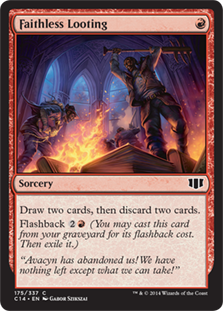 In a graveyard-based deck, Looting goes from a decent selection tool to a ridiculous spell. Players often have cards in hand they want in the graveyard anyway, and would happily expend cards binning otherwise. In this sense, Looting sometimes reads more like "draw 3" or "draw 4," an absurd rate for one mana. Combined with the dredge mechanic, things get even more out of hand.
In a graveyard-based deck, Looting goes from a decent selection tool to a ridiculous spell. Players often have cards in hand they want in the graveyard anyway, and would happily expend cards binning otherwise. In this sense, Looting sometimes reads more like "draw 3" or "draw 4," an absurd rate for one mana. Combined with the dredge mechanic, things get even more out of hand.
Looting even has applications in decks with fringe graveyard requirements. Grixis Shadow, for instance, has taken to running Looting as a 2-of based on its card selection merits alone, as my GRx Moon decks have for years. In short, having the card in a deck fundamentally changes the way that deck navigates the mid- to late-game. Lands are generally best deployed each turn to ensure access on mana-hungry turns; Looting turns that philosophy on its head, rewarding pilots for sandbagging lands in hand. When Looting is drawn, it can chew through the chaff immediately, making it a "draw 4" in certain situations. Similarly, Looting is great at transforming spare copies of hosers like Blood Moon into something worthwhile.
Resilience: 3
Hosers like Rest in Peace interact effectively with graveyard decks in general, but they only counter half of Faithless Looting—its flashback. I see bringing in targeted graveyard hate for this one card to be overkill akin to boarding in Surgical Extraction against Snapcaster Mage.
How affected Looting is by other hate cards depends on the deck it's played in. For example, ones with a higher curve will care less about Damping Sphere, while Phoenix struggles under the artifact. Still, since Looting incentivizes players to hold lands in hand, they are likely to have less mana to work with, making these kinds of effects somewhat irksome.
Splashability: 3
Looting fits best into decks with graveyard synergies, but most strategies can accommodate it. The cantrip merely asks that pilots be on R, incidentally the color of Modern's best card: Lightning Bolt. Besides Shadow, we've seen Looting break into other midrange shells before, including Jund.
Highly streamlined decks not relying on graveyard synergies have little use for Faithless Looting, and the same can be said of creature-dense combo strategies like Kiki-Chord.
Overall: 10/15
#2: Mox Opal
Power: 5
If you thought leading with Noble Hierarch was good...! Mox Opal can't be Bolted and it lets players take other actions on their first turn. It's the most efficient accelerator in Modern, in the Moxen tradition of being the most efficient accelerators in Magic. While it doesn't do much in many later-game scenarios (try as I might have to offset this detriment), Modern is still a Turn Four Format, and getting ahead by a turn right away—not to mention for free—tends to be hugely impactful. And while this Mox is legendary, it's still not totally dead in multiples, with extra copies acting as Lotus Petals.
Resilience: 5
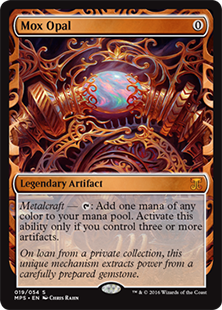 Thalia makes Opal cost one more. Ancient Grudge blows it up. Stony Silence turns it off. But all those cards cost two mana! There is no meaningful way to interact with the mana acceleration provided by Opal in the very early game, which is when it comes online.
Thalia makes Opal cost one more. Ancient Grudge blows it up. Stony Silence turns it off. But all those cards cost two mana! There is no meaningful way to interact with the mana acceleration provided by Opal in the very early game, which is when it comes online.
Splashability: 1
Every rose has its thorn, and Opal's is its strict requirement. Without metalcraft, the Mox does nothing, so it only fits into shells basically built around the card. No worries; we've seen Opal make massive waves in strategies ranging from Affinity to Ironworks, and I don't doubt plenty of new Opal decks, however viable, will emerge in Modern over the next few years.
Overall: 11/15
#1: Ancient Stirrings
Power: 5
Let's review Modern-era card selection cantrips. Opt and Sleight of Hand give players two looks into their deck to find the card they want. Serum Visions? Three. The banned Preordain gives three as well, but in a better sequence. Ponder, also banned (and even restricted in Vintage), gives players a whopping four looks for one mana. At the top of the heap rests Ancient Stirrings, which provides five.
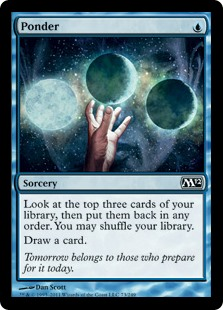 Granted, I think Ponder is better than Ancient Stirrings, both because it's more splashable and because of how nuts its stacking capabilities are with fetchlands in the picture. But when it comes to finding a specific card, Stirrings reigns supreme—on the condition players want to find something colorless.
Granted, I think Ponder is better than Ancient Stirrings, both because it's more splashable and because of how nuts its stacking capabilities are with fetchlands in the picture. But when it comes to finding a specific card, Stirrings reigns supreme—on the condition players want to find something colorless.
That condition has proven to not be as restrictive as Wizards may think. For starters, lands are colorless, meaning it automatically has about a 1/3 chance to hit. Decks looking for specific lands like Tron, Eldrazi, and Amulet Titan benefit immensely from this feature. Next, pilots should tweak their decks and sideboard to include colorless disruption (Engineered Explosives, Relic of Progenitus, Oblivion Stone, etc.) and proaction (Thought-Knot Seer, Wurmcoil Engine, Karn Liberated, etc.).
Of course, if the upside of finding a specific colorless card (i.e. Amulet of Vigor) is high enough, the other "rules" for running the cantrip can mostly go out the window. Like most cantrips, Stirrings is also great throughout the game: early on, it finds lands, and later, it finds business.
Resilience: 5
Stirrings is very difficult to hate out. While Thalia or Sphere technically slows it down, Stirrings itself does not encourage the cantrip-chaining gameplay that Scour and Manamorphose do. Players are likely to resolve Stirrings and then one other spell in a turn anyway, so a small tax affects them very little. Players looking for an edge against Stirrings decks prefer to leave the cantrip alone and attack aspects they have more control over, such as with Stony Silence or Alpine Moon.
Splashability: 2
 Here's where the deckbuilding restriction comes into play. While many Modern decks do play Ancient Stirrings (about a quarter of them), that number is still a clear minority for the reason that Stirrings can't be splashed willy-nilly. To accommodate the cantrip, players must either:
Here's where the deckbuilding restriction comes into play. While many Modern decks do play Ancient Stirrings (about a quarter of them), that number is still a clear minority for the reason that Stirrings can't be splashed willy-nilly. To accommodate the cantrip, players must either:
- Have colorless cards they benefit greatly from finding at certain points in a game
- Be composed primarily of colorless cards
- Be able to utilize available colorless disruption from the sideboard (i.e. Relic of Progenitus, Engineered Explosives)
Decks combining multiple criteria make even better homes for Stirrings, but the fact remains that the card can't go just anywhere. In some decks, that restriction just isn't a restriction, but the same can be said of the drawbacks on most enablers. According to Wizards' statements thus far, this predicament is only problematic for Modern if it translates to a diversity loss; Stirrings being stronger than Ponder in some decks does not matter in regards to the banlist.
Overall: 12/15
Are You an Enabler?
In addition to attacking from unconventional angles and circumventing hate, Ironworks maxed out on both of Modern's best enablers. Similarly, the other best-performing deck in the format runs the other three. Coincidence? You decide!





